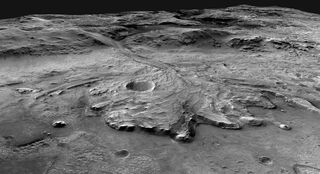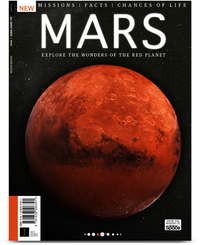NASA's Perseverance Mars rover is about to land in Jezero Crater. Here's what we know about the place.
Jezero Crater may be the proving ground in our search for Martian life.
If all goes to plan, NASA's Perseverance rover will alight at the location Thursday (Feb. 18) to start its multi-year quest to seek signs of habitability and cache particularly promising rocks for a future sample-return mission to bring to Earth's laboratories.
Picking the spot Percy will explore was an "exhaustive" process, NASA said in a statement, requiring five years of research examining 60 candidate locations. Mars sports abundant evidence of water and organic molecules, making it difficult to pick one single spot to answer the scientific questions driving the Mars 2020 mission.
7 minutes of terror: See the nail-biting Mars landing of the Perseverance rover

Book of Mars: <a href="https://www.awin1.com/awclick.php?awinmid=2961&awinaffid=103504&clickref=hawk-custom-tracking&p=https%3A%2F%2Fwww.magazinesdirect.com%2Faz-magazines%2F6942884%2Fbook-of-mars-2nd-edition.thtml" data-link-merchant="magazinesdirect.com"" target="_blank">$22.99 at Magazines Direct
Within 148 pages, explore the mysteries of Mars. With the latest generation of rovers, landers and orbiters heading to the Red Planet, we're discovering even more of this world's secrets than ever before. Find out about its landscape and formation, discover the truth about water on Mars and the search for life, and explore the possibility that the fourth rock from the sun may one day be our next home.
But NASA determined Jezero was a good location to show how water periodically appeared and then disappeared on the Martian surface. Scientists believe Mars lost its water because the atmosphere grew too thin, but about 3.5 billion years ago, Jezero appears to have been a potentially habitable river valley.
"Scientists see evidence that water carried clay minerals from the surrounding area into the crater lake," NASA representatives wrote in a description of the site. "Conceivably, microbial life could have lived in Jezero … If so, signs of their remains might be found in lakebed or shoreline sediments. Scientists will study how the region formed and evolved, seek signs of past life, and collect samples of Mars rock and soil that might preserve these signs."
When NASA selected Jezero in 2018, scientists said a delta is typically an ideal spot to search for signs of ancient life, which would likely be microbial.
Get the Space.com Newsletter
Breaking space news, the latest updates on rocket launches, skywatching events and more!
NASA's Perseverance Mars rover landing: Everything you need to know
"A delta is extremely good at preserving biosignatures, [be they] evidence of life that might have existed in the lake water, or at the interface between the sediment and the lake water, or, possibly, things that lived in the headwaters region that were swept in by the river and deposited in the delta," Mars 2020 project scientist Ken Farley, of NASA's Jet Propulsion Laboratory in California, said during a s conference held that November.
Jezero Crater is about 18 degrees north of the Martian equator and shows extensive variety in geology, allowing scientists to look at diverse rocks that may represent the planet's evolution over the eras. The site's drawback, however, is that the complex terrain poses danger during landing with obstacles such as sand dunes. The scientists also wanted to avoid touching down on the delta itself.






Long ago, Jezero contained a deep lake about the size of Lake Tahoe. The mission plan calls for Perseverance to land at the rim of the crater. The rover will wander over to the delta to examine the sediments, before examining the ancient shoreline and finally checking out some of the rocks at the rim of the crater.
"These rocks would have been hot shortly after the impact and may have hosted hot springs," scientist Ken Farley, of NASA's Jet Propulsion Laboratory, said in a December 2018 flyover video based on imagery collected by Mars orbiters. "Deposits from these springs would be another target in our search for possible ancient life on Mars."
Follow Elizabeth Howell on Twitter @howellspace. Follow us on Twitter @Spacedotcom and on Facebook.
Join our Space Forums to keep talking space on the latest missions, night sky and more! And if you have a news tip, correction or comment, let us know at: community@space.com.

Elizabeth Howell (she/her), Ph.D., is a staff writer in the spaceflight channel since 2022 covering diversity, education and gaming as well. She was contributing writer for Space.com for 10 years before joining full-time. Elizabeth's reporting includes multiple exclusives with the White House and Office of the Vice-President of the United States, an exclusive conversation with aspiring space tourist (and NSYNC bassist) Lance Bass, speaking several times with the International Space Station, witnessing five human spaceflight launches on two continents, flying parabolic, working inside a spacesuit, and participating in a simulated Mars mission. Her latest book, "Why Am I Taller?", is co-written with astronaut Dave Williams. Elizabeth holds a Ph.D. and M.Sc. in Space Studies from the University of North Dakota, a Bachelor of Journalism from Canada's Carleton University and a Bachelor of History from Canada's Athabasca University. Elizabeth is also a post-secondary instructor in communications and science at several institutions since 2015; her experience includes developing and teaching an astronomy course at Canada's Algonquin College (with Indigenous content as well) to more than 1,000 students since 2020. Elizabeth first got interested in space after watching the movie Apollo 13 in 1996, and still wants to be an astronaut someday. Mastodon: https://qoto.org/@howellspace
